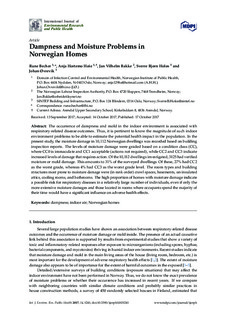| dc.contributor.author | Becher, Rune | |
| dc.contributor.author | Høie, Anja Hortemo | |
| dc.contributor.author | Bakke, Jan Vilhelm | |
| dc.contributor.author | Holøs, Sverre Bjørn | |
| dc.contributor.author | Øvrevik, Johan | |
| dc.date.accessioned | 2017-10-25T16:03:00Z | |
| dc.date.available | 2017-10-25T16:03:00Z | |
| dc.date.created | 2017-10-23T13:35:18Z | |
| dc.date.issued | 2017 | |
| dc.identifier.citation | International Journal of Environmental Research and Public Health. 2017, 14 (10), 1241-?. | nb_NO |
| dc.identifier.issn | 1660-4601 | |
| dc.identifier.uri | http://hdl.handle.net/11250/2462214 | |
| dc.description.abstract | The occurrence of dampness and mold in the indoor environment is associated with respiratory-related disease outcomes. Thus, it is pertinent to know the magnitude of such indoor environment problems to be able to estimate the potential health impact in the population. In the present study, the moisture damage in 10,112 Norwegian dwellings was recorded based on building inspection reports. The levels of moisture damage were graded based on a condition class (CC), where CC0 is immaculate and CC1 acceptable (actions not required), while CC2 and CC3 indicate increased levels of damage that requires action. Of the 10,112 dwellings investigated, 3125 had verified moisture or mold damage. This amounts to 31% of the surveyed dwellings. Of these, 27% had CC2 as the worst grade, whereas 4% had CC3 as the worst grade level. The room types and building structures most prone to moisture damage were (in rank order) crawl spaces, basements, un-insulated attics, cooling rooms, and bathrooms. The high proportion of homes with moisture damage indicate a possible risk for respiratory diseases in a relatively large number of individuals, even if only the more extensive moisture damages and those located in rooms where occupants spend the majority of their time would have a significant influence on adverse health effects | nb_NO |
| dc.language.iso | eng | nb_NO |
| dc.publisher | MDPI | nb_NO |
| dc.rights | Attribution-NonCommercial-NoDerivatives 4.0 Internasjonal | * |
| dc.rights.uri | http://creativecommons.org/licenses/by-nc-nd/4.0/deed.no | * |
| dc.subject | Inneklima | nb_NO |
| dc.subject | Indoor climate | nb_NO |
| dc.subject | Indoor air | nb_NO |
| dc.subject | Dampness | nb_NO |
| dc.subject | Norwegian homes | nb_NO |
| dc.title | Dampness and Moisture Problems in Norwegian Homes | nb_NO |
| dc.type | Journal article | nb_NO |
| dc.type | Peer reviewed | nb_NO |
| dc.description.version | publishedVersion | nb_NO |
| dc.rights.holder | © The Authors | nb_NO |
| dc.subject.nsi | VDP::Teknologi: 500 | nb_NO |
| dc.subject.nsi | VDP::Technology: 500 | nb_NO |
| dc.source.pagenumber | 1241-? | nb_NO |
| dc.source.volume | 14 | nb_NO |
| dc.source.journal | International Journal of Environmental Research and Public Health | nb_NO |
| dc.source.issue | 10 | nb_NO |
| dc.identifier.doi | 10.3390/ijerph14101241 | |
| dc.identifier.cristin | 1506843 | |
| cristin.unitcode | 7401,30,20,0 | |
| cristin.unitname | Bygninger og installasjoner | |
| cristin.ispublished | true | |
| cristin.fulltext | original | |
| cristin.qualitycode | 1 | |

